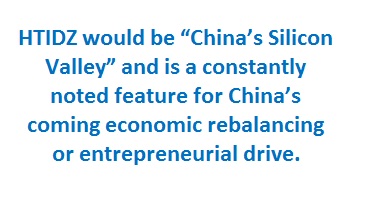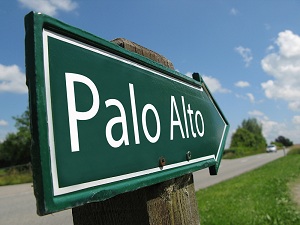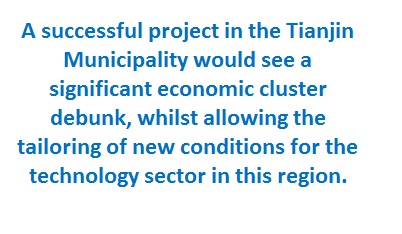Tianjin to be China’s Palo Alto?
By Richard J. Cook
In the coming years it may well be that Tianjin’s name will be standing beside Silicon Valley or Skolkovo, when it comes to globally acclaimed technology parks. The biggest hint yet came from the Municipal Planning Bureau last month, when it was announced that the next phase of the Beijing-Tianjin High-Technology Industrial Development Zone (HTIDZ) would be constructed in the Tianjin Municipality. This follows the previous establishment of the acclaimed Zhongguancun Science City located in Beijing. For those that have never heard of the Zhongguancun Science City, this is dubbed “China’s Silicon Valley” and is a constantly noted feature for China’s coming economic rebalancing or entrepreneurial drive.
Can Tianjin be China’s ‘Technopole’?
Tianjin’s own science city plan has been initiated and its construction is expected to span over the next 15 years, meaning that developments will come in a gradual fashion. The project will see Baodi, which is located to the north of Tianjin, transformed into a “high end innovation and entrepreneurial base.” The development is expected to draw in hundreds of home-grown Chinese technology companies as well as stirring start-ups in the sector. Tianjin has been selected due to its geo-economical position. Being close to some of the best universities in China and its proximity to Tianjin and Beijing’s combined economic clout is a significant factor in drawing upon the countries best and youthful minds to develop the sector. The region is also in the midst of a transportation overhaul, meaning key transport such as the availability of high-speed rail provides good logistics, acting as a key factor in choosing Tianjin Municipality.
 Continuing with China’s love of coining peculiar phrases for significant projects, the government described the project by saying it is, “three hearts, seven districts.” To decipher this phrase, it refers to a research and development centre, a business service centre and a logistics and trade centre as the “three hearts.” The “seven districts” refers to the technology park catering the needs for business intelligence, equipment intelligence, environmental protection, energy efficiency, innovative logistics, entrepreneurialism and residential areas. Generally speaking it refers to this project being a significant element to the Beijing-Tianjin inter-regional cooperation zone. More importantly the positioning of the project elaborates further on the formation of an industrial belt, spanning from Beijing, Tianjin to Tangshan, cited back in 2005 from Beijing’s 11th 5-year economic program. This industrial belt is to be the foundation stone for the development of a tri-super city area termed “Jing-Jin-Ji” which we will look at in later articles.
Continuing with China’s love of coining peculiar phrases for significant projects, the government described the project by saying it is, “three hearts, seven districts.” To decipher this phrase, it refers to a research and development centre, a business service centre and a logistics and trade centre as the “three hearts.” The “seven districts” refers to the technology park catering the needs for business intelligence, equipment intelligence, environmental protection, energy efficiency, innovative logistics, entrepreneurialism and residential areas. Generally speaking it refers to this project being a significant element to the Beijing-Tianjin inter-regional cooperation zone. More importantly the positioning of the project elaborates further on the formation of an industrial belt, spanning from Beijing, Tianjin to Tangshan, cited back in 2005 from Beijing’s 11th 5-year economic program. This industrial belt is to be the foundation stone for the development of a tri-super city area termed “Jing-Jin-Ji” which we will look at in later articles.
However, there is much competition from within China. Tianjin isn’t the only name to challenge for China’s next Silicon Valley. Shanghai has it’s own Zhangjiang High-Technology Park and not to mention Suzhou and Shenzhen, both with their own similar projects. As well as this, China has also initiated five other High-Technology Belt initiatives in the last few years, meaning there is ample competition from within.
HTIDZ Townships
 The US has set the contemporary trend for the establishment of HTIDZ townships over the last three decades from the staggering success of Silicon Valley. The remarkable success of this township model has been transmitted across the globe and in most cases has been a resounding success for home-grown technology innovation. It has been a long time coming that China desired to draw upon its developing critical mass of entrepreneurship to construct its own global franchise of HTIDZ class. As of 2009 some economists argued that the 50,000+ high-tech enterprises within HTIDZs were generating close to 10% of China’s GDP.
The US has set the contemporary trend for the establishment of HTIDZ townships over the last three decades from the staggering success of Silicon Valley. The remarkable success of this township model has been transmitted across the globe and in most cases has been a resounding success for home-grown technology innovation. It has been a long time coming that China desired to draw upon its developing critical mass of entrepreneurship to construct its own global franchise of HTIDZ class. As of 2009 some economists argued that the 50,000+ high-tech enterprises within HTIDZs were generating close to 10% of China’s GDP.
With the vast growth of Beijing and Tianjin, an economic cluster has arguably been created within the region, meaning the viable space needed to allow HTIDZ’s to be successful is a serious question. Referring to this issue, the construction of Tianjin’s HTIDZ at Baodi will allow certain conditions to attract the entrepreneurial mass needed, whilst freeing it from complex urban dynamics that cities have to combat. The town of Baodi can be regenerated to supply low cost living conditions for potential start-ups, which would otherwise be priced out of the industry in the likes of the Zhongguancun Science City or similar HTIDZ’s in Shanghai. Not to mention, Baodi would be somewhat protected from the horrific environmental conditions of Beijing, catering for political perception rhetoric when showcasing technological enhancements in China’s huge green sector.
Criticisms
Criticisms in recent years have branded similar schemes of the world’s 600+ HTIDZ’s as pure slogans of political rhetoric, rather than the true expressional aims of technology sector goals. Several other developing nations, notably Brazil, South Africa, India and Russia have all attempted to stage their own ‘Silicon Valley’ style technology revolutions, arguably showboating, with little true competitiveness. Yet government subsidies have been required in all the aforementioned countries, partly down to the significant struggle that these home-grown start-ups have to go through. Competing with the already established developed nations’ HTIDZ’s has proved challenging, thus it is easy to see why governments are so quick to parade successful ventures in developing countries. Also, the briskness in which these HTIDZ’s have been constructed has put quality issues to the forefront of debate. Tianjin’s own HTIDZ in Baodi, must therefore act as the gravitational epicentre for technological innovations in this sector and overcome issues surrounding quality in China, which is not an easy task.
Transforming Labour-Intensive Industry
 Along with the concepts of HTIDZ models there is the need for Tianjin to ensure that there is a continuous platform for converting the regional population from a labour-intensive industry to the high-tech intensive industry, to generate the desired ‘technopole’. Clustering educational establishments together to ferment results is commonplace in China’s new educational model. An example would be Tianjin’s new Haihe Education Park. However, it remains to be seen how universities in the region would interact with a HTIDZ in Baodi. There doesn't appear to be a ‘cluster’ formula here, unlike the Zhongguancun Science City in Beijing, which draws upon the young talent from Peking University and Tsinghua.
Along with the concepts of HTIDZ models there is the need for Tianjin to ensure that there is a continuous platform for converting the regional population from a labour-intensive industry to the high-tech intensive industry, to generate the desired ‘technopole’. Clustering educational establishments together to ferment results is commonplace in China’s new educational model. An example would be Tianjin’s new Haihe Education Park. However, it remains to be seen how universities in the region would interact with a HTIDZ in Baodi. There doesn't appear to be a ‘cluster’ formula here, unlike the Zhongguancun Science City in Beijing, which draws upon the young talent from Peking University and Tsinghua.
Aside from this, the HTIDZ at Baodi must compete effectively to ensure it does not lose out to other ‘technopoles’ around China or across the world. A shining example of failure so far would be the Indian models of HTIDZ. India, having to struggle with losing most of its significant technology entrepreneurial class to foreign countries, is attempting a HTIDZ resurgence but with little to show so far.
A successful project in the Tianjin Municipality would see a significant economic cluster debunk, whilst allowing the tailoring of new conditions for the technology sector in this region. The combined efforts of this plan, involving the Zhongguancun Science City and the development at Baodi are expected to raise 1 trillion yuan in revenue. Under current conditions and with the numbers predicted, the versatile pan-Beijing-Tianjin economic belt plan is finally coming together.
--- END ---